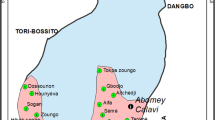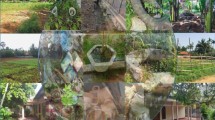Abstract
We conducted a cross-sectional study of Aedes vectors to assess the risk of dengue transmission and arbovirus outbreaks in Sargodha district, Pakistani Punjab. Pupae and 3rd and 4th instar larvae of the predominant vectors, Aedes aegypti and A. albopictus mosquitoes, were collected from houses and containers using different tools. Containers were catalogued according to type, location, sun exposure, lid status, water type, and water status. Breeding Preference Ratio (BPR) and larval indices were calculated. Sixty-seven of 1782 houses and 28 of 1494 containers were found infested. Among positive containers, discarded tires had the highest BPR (2.22), followed by barrels and polythene sheets (1.72). The highest absolute counts of Aedes mosquitos were found in plastic drums, whereas other species of mosquitos were highly detected also in jerry cans. The water containers with the highest infestation rates were indoors, in shady locations, only partially covered, and held clean or rain water. Awan and Farooq colonies were identified as high-risk areas, based on a high House Index (5.97 and 4.93, respectively). Our survey suggests that local authorities should promptly address the issue of growing vector populations, particularly in the Awan colony (to be referred as Priority class II area), in order to stem the risk of future epidemics. The number of mosquitoes can be substantially reduced by better handling specific breeding sites and educating people to properly store water.






Similar content being viewed by others
Data Availability
Data supporting the findings of this study are available from the corresponding author on reasonable request.
Change history
13 November 2023
A Correction to this paper has been published: https://doi.org/10.1007/s42690-023-01132-1
References
Ahmad S, Asif M, Yasir M, Nazir S, Majid M, Chaudhry MU (2016) Geographical information System Based Approach to Monitor Epidemiological Disaster: 2011 Dengue Fever Outbreak in Punjab, Pakistan. Int J Adv Comput Sci Appl 7(5). https://doi.org/10.14569/IJACSA.2016.070504
Ashfaq M, Hebert PD, Mirza JH, Khan AM, Zafar Y, Mirza MS (2014) Analyzing mosquito (Diptera: culicidae) diversity in Pakistan by DNA barcoding. PLoS ONE 9(5):e97268. https://doi.org/10.1371/journal.pone.0097268
Awan UA, Zahoor S, Ayub A, Ahmed H, Aftab N, Afzal MS (2021) COVID-19 and arboviral diseases: another challenge for Pakistan’s dilapidated healthcare system. J Med Virol 93(7):4065–4067. https://doi.org/10.1002/jmv.26668
Badar N, Salman M, Ansari J, Ikram A, Qazi J, Alam MM (2019) Epidemiological trend of chikungunya outbreak in Pakistan: 2016–2018. PLoS Negl Trop Dis 13(4):e0007118. https://doi.org/10.1371/journal.pntd.0007118
Barr KL, Khan E, Farooqi JQ, Imtiaz K, Prakoso D, Malik F, Lednicky JA, Long MT (2018) Evidence of Chikungunya Virus Disease in Pakistan since 2015 with patients demonstrating involvement of the Central Nervous System. Front Public Health 6:186. https://doi.org/10.3389/fpubh.2018.00186
Beltrán-Silva SL, Chacón-Hernández SS, Moreno-Palacios E, Pereyra-Molina JÁ (2018) Clinical and differential diagnosis: Dengue, chikungunya and ZikaDiagnóstico clínico y diferencial: dengue, chikunguña y zika. Revista Médica del Hospital General de México 81(3):146–153
Bhatt S, Gething PW, Brady OJ, Messina JP, Farlow AW, Moyes CL, Drake JM, Brownstein JS, Hoen AG, Sankoh O, Myers MF, George DB, Jaenisch T, Wint GR, Simmons CP, Scott TW, Farrar JJ, Hay SI (2013) The global distribution and burden of dengue. Nature 496(7446):504–507. https://doi.org/10.1038/nature12060
Brady OJ, Gething PW, Bhatt S, Messina JP, Brownstein JS, Hoen AG, Moyes CL, Farlow AW, Scott TW, Hay SI (2012) Refining the global spatial limits of dengue virus transmission by evidence-based consensus. PLoS Negl Trop Dis 6(8):e1760. https://doi.org/10.1371/journal.pntd.0001760
Census (2017) District Wise Results. Available at: https://www.pbs.gov.pk/census-2017-district-wise
Eisen L, Moore CG (2013) Aedes (Stegomyia) aegypti in the continental United States: a vector at the cool margin of its geographic range. J Med Entomol 50(3):467–478. https://doi.org/10.1603/me12245
Esser HJ, Mögling R, Cleton NB, van der Jeugd H, Sprong H, Stroo A, Koopmans MPG, de Boer WF, Reusken CBEM (2019) Risk factors associated with sustained circulation of six zoonotic arboviruses: a systematic review for selection of surveillance sites in non-endemic areas. Parasites & Vectors 12(1):265. https://doi.org/10.1186/s13071-019-3515-7
Getachew D, Tekie H, Gebre-Michael T, Balkew M, Mesfin A (2015) Breeding Sites of Aedes aegypti: potential dengue vectors in dire Dawa, East Ethiopia. Interdisciplinary Perspect Infect Dis 2015:706276. https://doi.org/10.1155/2015/706276
Guzmán MG, Kourí G (2002) Dengue: an update. Lancet Infect Dis 2(1):33–42. https://doi.org/10.1016/s1473-3099(01)00171-2
Harrison BA (2005) Field identification of adult and larval mosquitoes. Available at: https://www.gamosquito.org/resources/fguideid.pdf
Hwang JS, Roam GD (1994) Recovery and disposal of discarded tires in the Taiwan area. Gaoxiong yi xue ke xue za zhi = the Kaohsiung Journal of Medical Sciences 10(Suppl):S52–S55
Jones KE, Patel NG, Levy MA, Storeygard A, Balk D, Gittleman JL, Daszak P (2008) Global trends in emerging infectious diseases. Nature 451(7181):990–993. https://doi.org/10.1038/nature06536
Kaczmarek A, Wrońska AK, Boguś MI, Kazek M, Gliniewicz A, Mikulak E, Matławska M (2021) The type of blood used to feed Aedes aegypti females affects their cuticular and internal free fatty acid (FFA) profiles. PLoS ONE 16(4):e0251100. https://doi.org/10.1371/journal.pone.0251100
Khan U, Azeem S (2022) The rising toll of dengue cases in Pakistan every year: an incipient crisis. Annals of Medicine and Surgery (2012) 76:103549. https://doi.org/10.1016/j.amsu.2022.103549
Khan ZI, Ahmad K, Rehman S, Siddique S, Bashir H, Zafar A, Sohail M, Ali SA, Cazzato E, De Mastro G (2017) Health risk assessment of heavy metals in wheat using different water qualities: implication for human health. Environ Sci Pollut Res Int 24(1):947–955. https://doi.org/10.1007/s11356-016-7865-9
Kraemer MU, Sinka ME, Duda KA, Mylne AQ, Shearer FM, Barker CM, Moore CG, Carvalho RG, Coelho GE, Van Bortel W, Hendrickx G, Schaffner F, Elyazar IR, Teng HJ, Brady OJ, Messina JP, Pigott DM, Scott TW, Smith DL, Wint GR, …, Hay SI (2015) The global distribution of the arbovirus vectors aedes aegypti and ae. albopictus. eLife 4:e08347. https://doi.org/10.7554/eLife.08347
Kraemer MUG, Reiner RC Jr, Brady OJ, Messina JP, Gilbert M, Pigott DM, Yi D, Johnson K, Earl L, Marczak LB, Shirude S, Weaver D, Bisanzio N, Perkins D, Lai TA, Lu S, Jones X, Coelho P, Carvalho GE, Van Bortel RG, Golding W, N (2019) Past and future spread of the arbovirus vectors Aedes aegypti and Aedes albopictus. Nat Microbiol 4(5):854–863. https://doi.org/10.1038/s41564-019-0376-y
Kumar RR, Kamal S, Patnaik SK, Sharma RC (2002) Breeding habitats and larval indices of Aedes aegypti (L) in residential areas of Rajahmundry town, Andhra Pradesh. J Commun Dis 34(1):50–58
McNaughton D, Miller ER, Tsourtos G (2018) The importance of Water Typologies in Lay Entomologies of Aedes aegypti Habitat, breeding and dengue risk: a study from Northern Australia. Trop Med Infect Disease 3(2):67. https://doi.org/10.3390/tropicalmed3020067
Mousson L, Dauga C, Garrigues T, Schaffner F, Vazeille M, Failloux AB (2005) Phylogeography of Aedes (Stegomyia) aegypti (L.) and Aedes (Stegomyia) albopictus (Skuse) (Diptera: Culicidae) based on mitochondrial DNA variations. Genet Res 86(1):1–11. https://doi.org/10.1017/S0016672305007627
Ndiaye PI, Bicout DJ, Mondet B, Sabatier P (2006) Rainfall triggered dynamics of Aedes mosquito aggressiveness. J Theor Biol 243(2):222–229. https://doi.org/10.1016/j.jtbi.2006.06.005
Ogunlade ST, Meehan MT, Adekunle AI, Rojas DP, Adegboye OA, McBryde ES (2021) A review: Aedes-Borne Arboviral Infections, Controls and Wolbachia Based strategies. Vaccines 9(1):32. https://doi.org/10.3390/vaccines9010032
Paixão ES, Teixeira MG, Rodrigues LC (2018) Zika, chikungunya and dengue: the causes and threats of new and re-emerging arboviral diseases. BMJ Global Health 3(Suppl 1):e000530. https://doi.org/10.1136/bmjgh-2017-000530
Pliego Pliego E, Velázquez-Castro J, Eichhorn MP, Fraguela Collar A (2018) Increased efficiency in the second-hand tire trade provides opportunity for dengue control. J Theor Biol 437:126–136. https://doi.org/10.1016/j.jtbi.2017.10.025
Qureshi H, Khan MI, Bae SJ, Akhtar S, Khattak AA, Haider A, Nisar A (2023) Prevalence of dengue virus in Haripur district, Khyber Pakhtunkhwa, Pakistan. J Infect Public Health 16(7):1131–1136. https://doi.org/10.1016/j.jiph.2023.04.021
Ramzan H, Manzoor F, Oneeb M (2023) Current status of insecticide resistance and its underlying mechanisms in Aedes aegypti (L.) in Punjab, Pakistan. J Vector Borne Dis 60(1):57–64. https://doi.org/10.4103/0972-9062.353250
Rao BB, George B (2010) Breeding patterns of Aedes stegomyia albopictus in periurban areas of Calicut, Kerala, India. Southeast Asian J Trop Med Public Health 41(3):536–540
Rueda LM (2004) Pictorial keys for the identification of mosquitoes (Diptera: Culicidae) associated with dengue virus transmission. Zootaxa 589:1–60
Sanchez L, Cortinas J, Pelaez O, Gutierrez H, Concepción D, Van der Stuyft P (2010) Breteau Index threshold levels indicating risk for dengue transmission in areas with low Aedes infestation. Trop Med Int Health: TM IH 15(2):173–175. https://doi.org/10.1111/j.1365-3156.2009.02437.x
Souza-Neto JA, Powell JR, Bonizzoni M (2019) Aedes aegypti vector competence studies: a review. Infect Genet Evolution: J Mol Epidemiol Evolutionary Genet Infect Dis 67:191–209. https://doi.org/10.1016/j.meegid.2018.11.009
Tabassum S, Naeem A, Nazir A, Naeem F, Gill S, Tabassum S (2023) Year-round dengue fever in Pakistan, highlighting the surge amidst ongoing flood havoc and the COVID-19 pandemic: a comprehensive review. Annals of Medicine and Surgery (2012) 85(4):908–912. https://doi.org/10.1097/MS9.0000000000000418
Trewin BJ, Darbro JM, Zalucki MP, Jansen CC, Schellhorn NA, Devine GJ (2019) Life on the margin: Rainwater tanks facilitate overwintering of the dengue vector, Aedes aegypti, in a sub-tropical climate. PLoS ONE 14(4):e0211167. https://doi.org/10.1371/journal.pone.0211167
Udayanga L, Gunathilaka N, Iqbal MCM, Najim MMM, Pahalagedara K, Abeyewickreme W (2018) Empirical optimization of risk thresholds for dengue: an approach towards entomological management of Aedes mosquitoes based on larval indices in the Kandy District of Sri Lanka. Parasites & Vectors 11(1):368. https://doi.org/10.1186/s13071-018-2961-y
Acknowledgements
We thank Dr. Philip Cohen for double-checking English grammar and language.
Funding
No external funding was received for conducting this study.
Author information
Authors and Affiliations
Contributions
Conceptualization, methodology, investigation, data curation: SN, SSH, AA, SA. Writing - original draft: SN, GZ. Writing - review and editing: SN, GZ, GRP, MDP, TGP, VP. Formal analysis: GZ. Visualization: GZ. Resources: SN, SSH, GZ, AM. Supervision: FF, AM. SN and GZ have contributed equally to this work. All authors have read and approved the final version submitted.
Corresponding author
Ethics declarations
Conflict of interest
The authors declare no conflict of interest.
Institutional review board statement
Not applicable.
Ethics approval and consent to participate
This study did not involve clinical trials, human subjects, endangered or protected species; therefore, no ethics committee was involved. Mosquito samples were collected from local residences after obtaining the oral consent of household heads and property owners.
Additional information
Publisher’s Note
Springer Nature remains neutral with regard to jurisdictional claims in published maps and institutional affiliations.
The original version of this article has been corrected to replace Figure 5. Figure 5 included inaccurate statistical symbols that are now replaced.
Rights and permissions
Springer Nature or its licensor (e.g. a society or other partner) holds exclusive rights to this article under a publishing agreement with the author(s) or other rightsholder(s); author self-archiving of the accepted manuscript version of this article is solely governed by the terms of such publishing agreement and applicable law.
About this article
Cite this article
Naz, S., Zizzo, G., Habib, S.S. et al. Risk evaluation of Dengue virus transmission in Sargodha district (Punjab, Pakistan): a cross-sectional survey of Aedes mosquito infestation in houses and containers. Int J Trop Insect Sci 43, 1883–1893 (2023). https://doi.org/10.1007/s42690-023-01097-1
Received:
Accepted:
Published:
Issue Date:
DOI: https://doi.org/10.1007/s42690-023-01097-1




